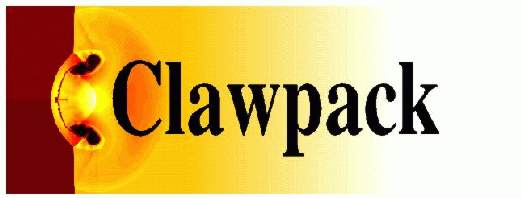|
bc1.f.html |
 |
|
Source file: bc1.f
|
|
Directory: /Users/rjl/git/rjleveque/clawpack-4.6.3/book/chap9/acoustics/layered
|
|
Converted: Mon Jan 21 2013 at 20:15:48
using clawcode2html
|
|
This documentation file will
not reflect any later changes in the source file.
|
c
c
c =================================================================
subroutine bc1(maxmx,meqn,mbc,mx,xlower,dx,q,maux,aux,t,dt,mthbc)
c =================================================================
c
c # Standard boundary condition choices for claw2
c
c # Modified for layered medium:
c # For small t oscillating solid wall BCs are used to generate pulse
c # For t>50, switch to periodic boundary conditions. The code
c # can then be run to much larger t to observe how the pulse
c # behaves as it loops around.
c
c # At each boundary k = 1 (left), 2 (right):
c # mthbc(k) = 0 for user-supplied BC's (must be inserted!)
c # = 1 for zero-order extrapolation
c # = 2 for periodic boundary coniditions
c # = 3 for solid walls, assuming this can be implemented
c # by reflecting the data about the boundary and then
c # negating the 2'nd component of q.
c ------------------------------------------------
c
c # Extend the data from the computational region
c # i = 1, 2, ..., mx2
c # to the virtual cells outside the region, with
c # i = 1-ibc and i = mx+ibc for ibc=1,...,mbc
c
implicit double precision (a-h,o-z)
dimension q(1-mbc:maxmx+mbc, meqn)
dimension aux(1-mbc:maxmx+mbc, *)
dimension mthbc(2)
common /comwall/ pi,t1,a1,tw1,t2,a2,tw2
c
c # switch to periodic boundary conditions once pulse is generated:
if (t .gt. 50.d0 .and. t .lt. 51.d0) then
mthbc(1) = 2
mthbc(2) = 2
do m=1,meqn
do ibc=1,mbc
aux(1-ibc,m) = aux(mx+1-ibc,m)
enddo
enddo
endif
c
c-------------------------------------------------------
c # left boundary:
c-------------------------------------------------------
go to (100,110,120,130) mthbc(1)+1
c
100 continue
c # user-specified boundary conditions
c # oscillating wall
do 105 m=1,meqn
do 105 ibc=1,mbc
q(1-ibc,m) = q(ibc,m)
105 continue
c # wall velocity:
vwall = a1*g0((t-t1)/tw1)
c # adjust the normal velocity:
do 106 ibc=1,mbc
q(1-ibc,2) = 2.0d0*vwall - q(ibc,2)
106 continue
go to 199
c
110 continue
c # zero-order extrapolation:
do 115 m=1,meqn
do 115 ibc=1,mbc
q(1-ibc,m) = q(1,m)
115 continue
go to 199
120 continue
c # periodic:
do 125 m=1,meqn
do 125 ibc=1,mbc
q(1-ibc,m) = q(mx+1-ibc,m)
125 continue
go to 199
130 continue
c # solid wall (assumes 2'nd component is velocity or momentum in x):
do 135 m=1,meqn
do 135 ibc=1,mbc
q(1-ibc,m) = q(ibc,m)
135 continue
c # negate the normal velocity:
do 136 ibc=1,mbc
q(1-ibc,2) = -q(ibc,2)
136 continue
go to 199
199 continue
c
c-------------------------------------------------------
c # right boundary:
c-------------------------------------------------------
go to (200,210,220,230) mthbc(2)+1
c
200 continue
c # user-specified boundary conditions
c # oscillating wall
do 205 m=1,meqn
do 205 ibc=1,mbc
q(mx+ibc,m) = q(mx+1-ibc,m)
205 continue
c # wall velocity:
vwall = a2*g0((t-t2)/tw2)
c # adjust the normal velocity:
do 206 ibc=1,mbc
q(mx+ibc,2) = 2.0d0*vwall - q(mx+1-ibc,2)
206 continue
go to 299
210 continue
c # zero-order extrapolation:
do 215 m=1,meqn
do 215 ibc=1,mbc
q(mx+ibc,m) = q(mx,m)
215 continue
go to 299
220 continue
c # periodic:
do 225 m=1,meqn
do 225 ibc=1,mbc
q(mx+ibc,m) = q(ibc,m)
225 continue
go to 299
230 continue
c # solid wall (assumes 2'nd component is velocity or momentum in x):
do 235 m=1,meqn
do 235 ibc=1,mbc
q(mx+ibc,m) = q(mx+1-ibc,m)
235 continue
do 236 ibc=1,mbc
q(mx+ibc,2) = -q(mx+1-ibc,2)
236 continue
go to 299
299 continue
c
return
end
c ===============================
double precision function g0(t)
c ===============================
implicit double precision (a-h,o-z)
common /comwall/ pi,t1,a1,t2,a2,tw1,tw2
if (dabs(t) .lt. 1.d0) then
g0 = 1.d0 + dcos(pi*t)
else
g0 = 0.d0
endif
return
end

